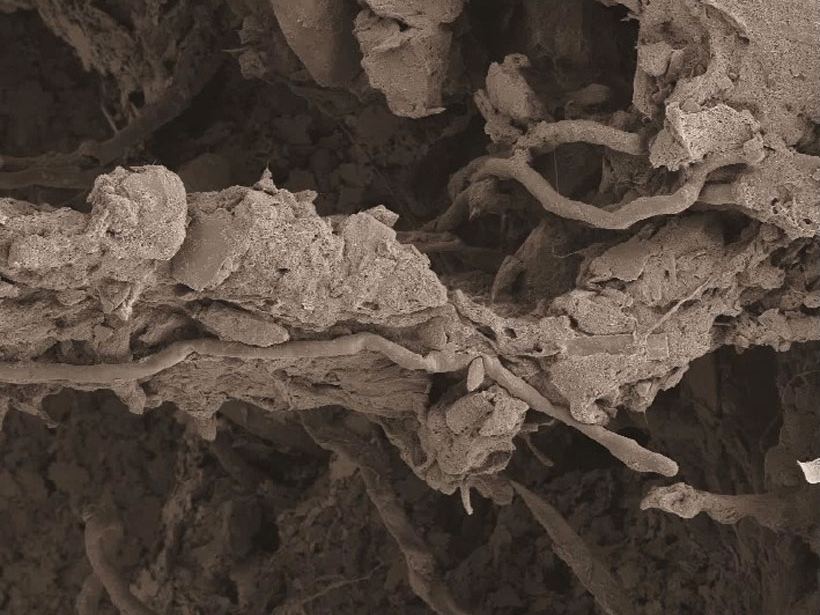All over the world, microbes destroy rocks to access precious nutrients like the iron locked inside. In a lab in Washington, D. C., researchers zoomed in on one particular microbe, the fungus Talaromyces flavus, to see just how this is done.
In a paper published this month in Geology, the researchers document their observations of the fungus as it obliterates its rocky environment using a mix of acid and mechanical force. Although it’s known that microbes like bacteria and fungi can wear away rocks, previous researchers estimated that fungi only contribute 1% to total bioweathering, said Henry Teng, a geochemist at George Washington University and coauthor of the paper. After watching T. flavus burrow into the mineral to extract essential nutrients, Teng and his team suggest that fungal weathering could actually be 40%–50% of all bioweathering.
Meal of Stone
The researchers collected the fungus from a serpentine mine in Donghai, China, where they were specifically looking for microbes that efficiently extract nutrients. Back in the lab, Teng’s team looked closely at the fungal activity at the fungus-rock interface. This interface has generally been overlooked, Teng said; other scientists have focused on microbes mixed in a solution with crushed minerals. In this study, Teng and his colleagues allowed the fungus to actually colonize a sample of a mineral.
In real-world soil and rock conditions, after all, “microbes are crawling on the surface of the rock,” Teng continued. “They don’t stay in a suspended state.”
Under a powerful microscope, the researchers could see markings left over from the microbes’ feast.
To study the fungus’s culinary routine, the researchers placed cells on tiny samples of the mineral lizardite, which usually is made up of magnesium, silicon, oxygen, and hydrogen but often contains traces of iron. After 4 days, the fungus’s life ended in a cascade of chemicals as the researchers washed the mineral samples to inspect them more closely. Under a powerful microscope, the researchers could see nanometer-scale markings left over from the microbes’ feast—long, thin channels and small, round pits.
The researchers then pinned down the fungus’s methods of attack.
Fungal Attack
When the microbe first encounters the mineral’s surface, its spores secrete acid that drops the pH by a factor of 10, creating a highly acidic environment in which to dissolve the rock and extract precious life-sustaining iron. An extra step requires the microbe to also secrete a type of chemical called a siderophore that allows it to ingest the iron. Once the fungus extracts all the iron—and lizardite doesn’t contain much—it extends tiny filaments called hyphae to burrow through the remaining layer of silica to get to more nutrients, leaving behind channels stretching 200–2000 nanometers (to compare, a strand of human hair is about 80,000 nanometers thick).

Further, Teng noticed places attacked by the fungus on the rock surface where the usual orderly crystalline structure of the mineral had become amorphous, “meaning there are mechanical forces involved in destroying this [mineral],” rather than just chemical forces, Teng said. He suspects that this kind of pummeling may be unique to the fungus.
Over the course of the experiment, the fungus placed on the lizardite destroyed more rock than fungus in a solution with crushed lizardite. In the solution with the fungus, the researchers didn’t see the physical leftovers of the hyphea’s attack, nor did they find high levels of siderophore, leading them to suggest that the fungus-mineral interface is more important than once thought.
Root Symbiosis
“Compared to bacteria, fungi are overlooked, understudied, and very few studies [looked] at these interfaces between fungi and mineral.”
”Compared to bacteria, fungi are overlooked, understudied, and very few studies [looked] at these interfaces between fungi and mineral,” said Steeve Bonneville , a biogeochemist at the Free University of Brussels in Belgium who was not involved in the paper, which he called “a very solid study.” The new research provides evidence that “fungi can be a major player in mineral alteration and more generally in biogeochemical cycles,” Bonneville said.
The Geology study could give scientists a better understanding of how plants absorb nutrients, said Teng. In most cases, plants don’t extract nutrients from the soil themselves but rely heavily on soil microbes to break down rocks and release nutrients such as iron, nitrogen, and phosphorous, he noted.
“Most of the nutrients in rock and soil are in geological form,” Teng said. “Roots cannot directly use that. Plants depend on the fungi to colonize their roots.”
However, Bonneville said that the laboratory experiments used in the new study were rather simplistic and that “there [were] no bacteria, plant roots, and no other fungi to interact with or prey on the fungal strain.” In a similar study conducted by Bonneville in 2011, he and his team observed fungal colonies growing on the mineral biotite in a controlled environment that also hosted plant roots and other bacteria. In that study, Bonneville found similar results—that fungal hyphae alter the underlying rock.
—JoAnna Wendel, Staff Writer
Citation: Wendel, J. (2016), Using acid and physical force, fungi burrow through rock, Eos, 97, doi:10.1029/2016EO048621. Published on 21 March 2016.
Text © 2016. The authors. CC BY-NC 3.0
Except where otherwise noted, images are subject to copyright. Any reuse without express permission from the copyright owner is prohibited.

